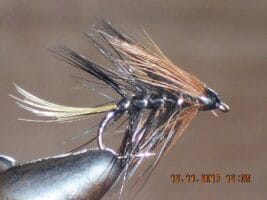Your cart is currently empty!
Tube fly 21
Upgrade your fly fishing arsenal with our premium tube flies, meticulously hand-tied using the finest fox tails and buck tails. Our extensive online selection features an array of colors and sizes (1, 1/4, 1/2) to suit your angling needs. Discover the Elburgon Flies Supply difference and buy your tube flies from us today.
Description
Tube Fly 21 : Durable tube flies patterns for sale
The Tube Fly 21 represents the pinnacle of tube fly design, combining premium fox tail and buck tail materials with expert construction techniques. This meticulously crafted pattern delivers exceptional performance across various fishing conditions and target species.
Design Excellence and Innovation
The pattern showcases sophisticated design elements that set it apart from standard tube flies. Its carefully proportioned materials create a natural, flowing profile that perfectly mimics baitfish and other prey, while the tube construction allows for customizable hook options. The combination of premium materials and precise tying techniques results in a pattern that both looks and performs exceptionally well.
Material Selection and Technical Construction
Every component is carefully selected for both performance and durability:
- Premium-grade fox tail
- High-quality buck tail
- Strategic flash material placement
- Durable tube construction
- Multiple size options (1, 1/4, 1/2)
- Reinforced construction techniques
Strategic Fishing Applications
This pattern excels in multiple fishing scenarios:
- Deep pools and runs
- Fast-moving water
- Structure fishing
- Open water presentations
- Various depth ranges Each environment allows the pattern to showcase its effectiveness.
Seasonal Effectiveness?The pattern demonstrates remarkable productivity throughout the year:
- Spring: Pre-spawn feeding periods
- Summer: Early morning and evening
- Fall: Baitfish migration periods
- Winter: Deep-water presentations Seasonal adaptations in presentation maximize success.
Species-Specific Performance?While primarily designed for predatory fish, the pattern proves deadly for:
- Large Brown Trout
- Rainbow Trout in rivers
- Steelhead during runs
- Bass in clear water
- Various predatory species
Water Presentation Characteristics?Superior presentation qualities include:
- Natural swimming action
- Realistic baitfish profile
- Effective flash patterns
- Perfect silhouette
- Attractive movement at all speeds
Advanced Retrieval Techniques?To maximize the pattern’s effectiveness:
- Strip-pause retrieve
- Steady swimming action
- Erratic movements
- Dead-drift presentations
- Swing techniques
Technical Advantages?Key performance benefits include:
- Optimal weight distribution
- Natural movement in current
- Excellent hook-up ratio
- Durable construction
- Versatile fishing depths
Line and Leader Configuration?For optimal presentation:
- Floating lines for shallow water
- Intermediate lines for consistent depth
- Sinking lines for deep water
- Strong tippet material
- Shorter leader lengths
Environmental Adaptability?The pattern performs consistently across:
- Various water clarities
- Different current speeds
- Multiple depth ranges
- Various light conditions
- Different temperature ranges
Competition and Professional Applications?The Tube Fly 21 has established itself in serious angling:
- Tournament-proven pattern
- Guide’s choice for clients
- Professional competition use
- Training pattern for tube fly fishing
- Reliable producer in pressure situations
Size Variations and Pattern Modifications?Available in multiple configurations:
- Full size (1)
- Quarter size (1/4)
- Half size (1/2)
- Hook style options
- Weight modifications
Storage and Maintenance Requirements?To maintain optimal performance:
- Store in ventilated compartments
- Avoid compression
- Regular material grooming
- Proper drying essential
- Hook maintenance
Advanced Rigging Techniques?Multiple rigging options enhance versatility:
- Traditional tube fly setup
- Various hook configurations
- Weight adjustments
- Leader modifications
- Specialized presentations
Historical Context and Evolution?The pattern’s development reflects:
- Traditional tube fly patterns
- Modern material incorporation
- Refined proportions
- Proven effectiveness
- Continuous improvement
Quality Control Standards?Each fly maintains strict requirements:
- Precise material selection
- Proper proportioning
- Construction integrity
- Flash placement
- Pattern uniformity
Fishing Location Selection?Optimal fishing locations include:
- Structure-rich areas
- Deep pools
- Current seams
- Drop-offs
- Undercut banks
Weather and Condition Considerations?Pattern effectiveness varies with:
- Water clarity
- Light conditions
- Current speed
- Temperature
- Barometric pressure
Presentation Depth Control?Achieving proper depth through:
- Line selection
- Retrieve speed
- Cast angle
- Current reading
- Weight adjustment
Color and Flash Characteristics?The pattern’s materials provide:
- Natural coloration
- Attractive flash
- Depth adaptability
- Light reflection properties
- Contrast in various conditions
Movement Characteristics?Natural movement achieved through:
- Fox tail undulation
- Buck tail action
- Body taper design
- Weight distribution
- Material interaction
Durability Features?Construction elements ensuring longevity:
- Reinforced tube construction
- Quality material selection
- Proper proportioning
- Strategic material attachment
- Hook system protection
Target Species Behavior?Understanding fish response to:
- Profile presentation
- Movement triggers
- Flash attraction
- Depth preferences
- Feeding patterns
Water Type Adaptations?Effective across various waters:
- Rivers and streams
- Lakes and ponds
- Coastal waters
- Tailwaters
- Spring creeks
Casting Techniques?Specialized casting methods:
- Distance casting
- Accuracy requirements
- Line control
- Presentation angles
- Wind adaptation
Strike Detection?Recognizing takes through:
- Visual observation
- Line movement
- Leader reaction
- Strip resistance
- Surface disturbance
Hook Setting Techniques?Proper hook setting through:
- Strip-set method
- Timing considerations
- Pressure control
- Direction control
- Follow-through
Fighting Techniques?Landing fish effectively:
- Pressure application
- Direction control
- Line management
- Fish behavior adaptation
- Landing strategies
Additional information
| Hook size | 1, 1/2, 1/4 |
|---|---|
| Hook type | Copper, Plastic, Silver |







